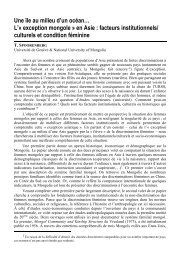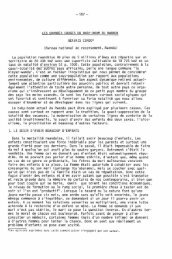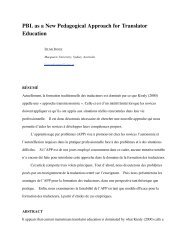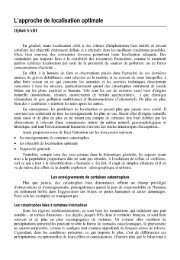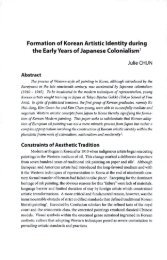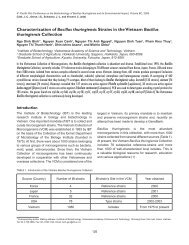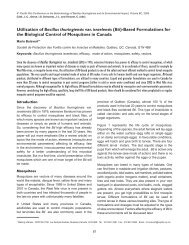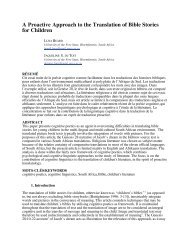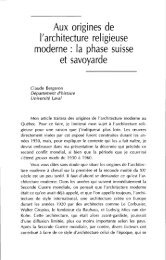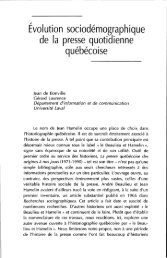Religious Art in Iran during the Qajar Epoch: Breaking the Boundaries
Religious Art in Iran during the Qajar Epoch: Breaking the Boundaries
Religious Art in Iran during the Qajar Epoch: Breaking the Boundaries
You also want an ePaper? Increase the reach of your titles
YUMPU automatically turns print PDFs into web optimized ePapers that Google loves.
<strong>Religious</strong> <strong>Art</strong> <strong>in</strong> <strong>Iran</strong> dur<strong>in</strong>g <strong>the</strong> <strong>Qajar</strong><br />
<strong>Epoch</strong>: Break<strong>in</strong>g <strong>the</strong> <strong>Boundaries</strong><br />
Mahshid MODARES<br />
Abstract<br />
This article <strong>in</strong>vestigates <strong>the</strong> murals of Armenian churches that became <strong>the</strong> first<br />
examples of <strong>the</strong> comb<strong>in</strong>ation of figurative European stylistic features and nonflgurative<br />
geometrical and arabesque Islamic motifs <strong>in</strong> a sacred place <strong>in</strong> <strong>Iran</strong>. This quality became<br />
one of <strong>the</strong> ma<strong>in</strong> characteristics <strong>in</strong> decorat<strong>in</strong>g Islamic structures dur<strong>in</strong>g <strong>the</strong> <strong>Qajar</strong><br />
era (1795-1925)'. <strong>Iran</strong>ian artists of this period <strong>in</strong>troduced a dist<strong>in</strong>ctive composition <strong>in</strong><br />
which European-style figurative images became <strong>the</strong> focal po<strong>in</strong>t <strong>in</strong> a section of wall or<br />
ceil<strong>in</strong>g, while arabesque and geometrical patterns frame <strong>the</strong> figurative parts, <strong>the</strong>refore,<br />
decreas<strong>in</strong>g <strong>the</strong> importance of <strong>the</strong> symbolic mean<strong>in</strong>g of Islamic traditional patterns used<br />
for centuries <strong>in</strong> <strong>Iran</strong>. <strong>Qajar</strong> artists were <strong>in</strong> fact <strong>the</strong> first <strong>Iran</strong>ian artists who broke <strong>the</strong><br />
rule restrict<strong>in</strong>g <strong>the</strong> use of figurative images on Islamic structures and <strong>the</strong>y provided<br />
life-size images of holy <strong>in</strong>dividuals show<strong>in</strong>g <strong>the</strong>ir faces. This phenomenon is one of<br />
<strong>the</strong> vital Factors of <strong>the</strong> art dur<strong>in</strong>g <strong>the</strong> late eighteenth and n<strong>in</strong>eteenth centuries s<strong>in</strong>ce<br />
it demonstrates how much European art held sway over art <strong>in</strong> <strong>Iran</strong> and <strong>in</strong> what way<br />
religious art reflected cultural and social changes.<br />
Dur<strong>in</strong>g <strong>the</strong> <strong>Qajar</strong> period, especially <strong>in</strong> <strong>the</strong> second half of <strong>the</strong> n<strong>in</strong>eteenth century,<br />
social and cultural transformations occurred because of <strong>the</strong> <strong>Iran</strong>ian attitude<br />
toward religion, <strong>the</strong> recognition of a person as an <strong>in</strong>dividual and as a valued member<br />
of <strong>the</strong> society, an <strong>in</strong>terest <strong>in</strong> European culture and art which was accepted as<br />
modern and superior, and a change <strong>in</strong> government accountability. As materialism<br />
started to become more important than religious beliefs <strong>in</strong> <strong>the</strong> m<strong>in</strong>ds of <strong>the</strong> people,<br />
question<strong>in</strong>g social and cultural values commenced. The result was <strong>the</strong> 1906-1907<br />
Constitutional Movement as a step toward democracy and a more secular society.<br />
Also, people looked for new experiences <strong>in</strong> <strong>the</strong> educational system, <strong>in</strong> literature, and<br />
<strong>in</strong> art. Dur<strong>in</strong>g <strong>the</strong> late eighteenth and early n<strong>in</strong>eteenth centuries, art became more<br />
descriptive to meet <strong>the</strong> <strong>in</strong>creas<strong>in</strong>gly materialistic aspirations of its patrons. From<br />
about <strong>the</strong> 1840s until <strong>the</strong> 1910s, however, <strong>the</strong> need to <strong>in</strong>dicate <strong>the</strong> <strong>in</strong>dividual characteristics<br />
of <strong>the</strong> sitters came to be of great <strong>in</strong>terest, a notable degree of which is owed<br />
to study<strong>in</strong>g European pa<strong>in</strong>t<strong>in</strong>g.
ACTES DU 8" COLLOQUE ÉTUDIANT DU DÉPARTEMENT D'HISTOIRE<br />
The <strong>in</strong>fluence of European art on <strong>Iran</strong>ian pa<strong>in</strong>t<strong>in</strong>g began <strong>in</strong> <strong>the</strong> Safavid epoch<br />
(1502-1736) 2 , but it affected <strong>the</strong> art of murals more than traditional Persian manuscript<br />
illum<strong>in</strong>ation. In that period, <strong>the</strong> art of <strong>the</strong> Italian Renaissance, as well as Dutch<br />
Baroque pa<strong>in</strong>t<strong>in</strong>g, were <strong>in</strong>troduced to <strong>Iran</strong>ian artists and <strong>the</strong>ir patrons, and <strong>the</strong> demand<br />
for this new art <strong>in</strong>creased. These certa<strong>in</strong> artistic styles from Europe gave<br />
artists <strong>the</strong> opportunity to experiment with three-dimensional representation, <strong>the</strong><br />
use of light, <strong>the</strong> shape of a human body, and l<strong>in</strong>ear perspective to <strong>in</strong>dicate depth as<br />
seen <strong>in</strong> European pa<strong>in</strong>t<strong>in</strong>gs. The pa<strong>in</strong>t<strong>in</strong>gs and murals of <strong>the</strong> Safavid era, <strong>the</strong>refore,<br />
are constructive examples of <strong>the</strong> first l<strong>in</strong>ks between European pa<strong>in</strong>t<strong>in</strong>gs and <strong>Iran</strong>ian<br />
image mak<strong>in</strong>g followed by artists of <strong>the</strong> <strong>Qajar</strong> period extensively. In <strong>the</strong> 1620s, as <strong>the</strong><br />
presence of European travelers and artists <strong>in</strong> Isfahan, <strong>the</strong> Safavid capital, <strong>in</strong>creased,<br />
so did <strong>the</strong> number of commissions for European-style realistic pa<strong>in</strong>t<strong>in</strong>gs and murals.<br />
The murals of <strong>the</strong> Safavid epoch also show <strong>the</strong> <strong>in</strong>spiration of European art<br />
specifically on religious art. Dur<strong>in</strong>g this period, Armenians were brought from <strong>the</strong><br />
Turkish borders and settled <strong>in</strong> Isfahan by Shah Abbas I (1587-1629 A.D.) to protect<br />
<strong>the</strong>m from Turkish <strong>in</strong>cursions'. Armenian merchants who traveled to Europe<br />
brought back numerous pieces of artwork, many of which are still on display <strong>in</strong> <strong>the</strong><br />
Vank Museum, <strong>in</strong> <strong>the</strong> Jolfa suburb of Isfahan. These pa<strong>in</strong>t<strong>in</strong>gs <strong>in</strong>clude portraits<br />
and figures, landscapes and still lifes <strong>in</strong> <strong>the</strong> Italian Renaissance style. Pa<strong>in</strong>ted <strong>in</strong> oil,<br />
most canvases are religious portrayals of Christ and <strong>the</strong> Virg<strong>in</strong> Mary, pa<strong>in</strong>ted and<br />
purchased <strong>in</strong> Europe by Armenian traders, who would <strong>in</strong> turn donate <strong>the</strong>m to <strong>the</strong><br />
churches <strong>in</strong> Isfahan 4 . Eventually, <strong>the</strong> pa<strong>in</strong>t<strong>in</strong>gs became effective models for <strong>Iran</strong>ian<br />
artists and helped <strong>the</strong>m become familiar with new techniques, especially oil on canvas.<br />
In addition, <strong>the</strong> walls of <strong>the</strong> churches that were built <strong>in</strong> <strong>the</strong> Safavid era, such<br />
as Betlaham Church (built <strong>in</strong> 1628), Vank Ca<strong>the</strong>dral (built <strong>in</strong> 1655), and George<br />
Church (completed <strong>in</strong> 1719), were covered with murals depict<strong>in</strong>g <strong>the</strong> life of Christ,<br />
<strong>the</strong> Virg<strong>in</strong> Mary, and Judgment Day 5 .<br />
One example is <strong>the</strong> murals on <strong>the</strong> walls and ceil<strong>in</strong>gs of Vank Ca<strong>the</strong>dral attributed<br />
to an <strong>Iran</strong>ian-Armenian artist named M<strong>in</strong>as, who was born <strong>in</strong> <strong>the</strong> first half<br />
of <strong>the</strong> seventeenth century. Dur<strong>in</strong>g his childhood, M<strong>in</strong>as's family moved to Halab,<br />
Syria, where he was tra<strong>in</strong>ed by a European artist. After return<strong>in</strong>g to Isfahan, he was<br />
commissioned to provide murals for palaces and merchants' houses and became<br />
<strong>the</strong> chief pa<strong>in</strong>ter of <strong>the</strong> murals <strong>in</strong> <strong>the</strong> Betlaham Church 6 . The Church murals were<br />
probably pa<strong>in</strong>ted around <strong>the</strong> 1640s 7 . S<strong>in</strong>ce both <strong>the</strong> technique used and some images<br />
pa<strong>in</strong>ted <strong>in</strong> Betlaham Church are very similar to <strong>the</strong> ones <strong>in</strong> Vank Ca<strong>the</strong>dral, it<br />
is more than likely that M<strong>in</strong>as pa<strong>in</strong>ted <strong>the</strong> walls of <strong>the</strong> Vank Ca<strong>the</strong>dral, as well. As<br />
seen <strong>in</strong> Figure 1, <strong>the</strong> figures are pa<strong>in</strong>ted wear<strong>in</strong>g green, red, or brown Roman-style<br />
robes or <strong>the</strong>y are nude. The angels are dist<strong>in</strong>guished by w<strong>in</strong>gs and <strong>the</strong> figures of <strong>the</strong><br />
Virg<strong>in</strong> Mary and Christ are pa<strong>in</strong>ted with gold halos beh<strong>in</strong>d <strong>the</strong>ir heads. God, who<br />
120
Contacts, médiations et transferts <strong>in</strong>terculturels<br />
is pa<strong>in</strong>ted on <strong>the</strong> upper part of <strong>the</strong> niche, appears as an old bearded man wear<strong>in</strong>g<br />
red and green Roman-style robes, sitt<strong>in</strong>g between <strong>the</strong> clouds and <strong>the</strong> light. By us<strong>in</strong>g<br />
light and several hues <strong>the</strong> artist suggests <strong>the</strong> texture of <strong>the</strong> sk<strong>in</strong> and <strong>the</strong> form of <strong>the</strong><br />
bodies under <strong>the</strong>ir clo<strong>the</strong>s, as well as some three-dimensionality, an aspect assisted<br />
by <strong>the</strong> colors of <strong>the</strong> background and <strong>the</strong> landscape beh<strong>in</strong>d <strong>the</strong> figures.<br />
One fasc<strong>in</strong>at<strong>in</strong>g characteristic of <strong>the</strong>se murals is that <strong>the</strong> biblical stories pa<strong>in</strong>ted<br />
<strong>in</strong> a European style are surrounded by Islamic nonfigurative motifs done primarily<br />
<strong>in</strong> gold and blue. Nei<strong>the</strong>r <strong>the</strong> figurative images nor <strong>the</strong> Islamic motifs seem<br />
dom<strong>in</strong>ant or overwhelm<strong>in</strong>g; <strong>the</strong>y are harmoniously balanced. The fact that Armenian<br />
artists and Muslim artists worked toge<strong>the</strong>r to create such sublime artwork is<br />
not only unusual historically, but it also <strong>in</strong>dicates <strong>the</strong> first evidence of Muslim artists<br />
see<strong>in</strong>g figurative pa<strong>in</strong>t<strong>in</strong>gs used <strong>in</strong> <strong>Iran</strong> for a religious purpose alongside Islamic<br />
nonfigurative motifs*. This concept was not used <strong>in</strong> mosques or o<strong>the</strong>r religious<br />
structures built dur<strong>in</strong>g <strong>the</strong> Safavid era, but it was employed <strong>in</strong> <strong>the</strong> holy shr<strong>in</strong>es of<br />
<strong>the</strong> <strong>Qajar</strong> epoch.<br />
<strong>Qajar</strong> shahs, courtiers, and court aristocrats commissioned pa<strong>in</strong>t<strong>in</strong>gs, tiles,<br />
and murals for <strong>the</strong> newly built mosques, mausoleums, Tekiyehs (where religious rituals<br />
were performed), and Sagha-khaneh (<strong>in</strong>dividual rooms where people could<br />
dr<strong>in</strong>k fresh water and pray for <strong>the</strong> builder)". The religious images and <strong>the</strong> images <strong>in</strong><br />
Islamic structures <strong>in</strong> <strong>the</strong> form of illustrations, pa<strong>in</strong>t<strong>in</strong>gs, carpets, tile designs, stone<br />
relief or murals can be divided <strong>in</strong>to figurative images of nature and still lifes, portraiture<br />
and figures of holy <strong>in</strong>dividuals specifically <strong>the</strong> Prophet Mohammad and <strong>the</strong><br />
Imams, and sometimes <strong>the</strong> patrons as well as narrative images describ<strong>in</strong>g religious<br />
<strong>in</strong>cidents or legends, and figures of ord<strong>in</strong>ary people conduct<strong>in</strong>g different tasks or<br />
practic<strong>in</strong>g <strong>the</strong>ir daily prayer.<br />
Some shr<strong>in</strong>es conta<strong>in</strong> images of still lifes or landscapes <strong>in</strong> <strong>the</strong> form of tiles and<br />
murals for decorative purposes. Before <strong>the</strong> <strong>Qajar</strong> period, stylized geometrical or<br />
arabesque patterns were used <strong>in</strong> sacred places but it was unusual for figurative images<br />
to be <strong>in</strong>cluded on Islamic structures due to <strong>the</strong> restrictions on <strong>the</strong> use of figurai<br />
imagery <strong>in</strong> mosques. <strong>Qajar</strong> artists challenged such a prohibition for <strong>the</strong> first time<br />
<strong>in</strong> <strong>Iran</strong>. Such an action <strong>in</strong>dicates <strong>the</strong> changes <strong>in</strong> <strong>the</strong> culture and <strong>the</strong> patrons' po<strong>in</strong>t<br />
of view about religion <strong>in</strong> terms of <strong>the</strong>ir <strong>in</strong>creas<strong>in</strong>g openness toward accept<strong>in</strong>g new<br />
experiments <strong>in</strong> religious art, and <strong>the</strong>ir desire for European realistic style pa<strong>in</strong>t<strong>in</strong>g.<br />
These figurative images marked a new era <strong>in</strong> <strong>the</strong> history of religious art <strong>in</strong> <strong>Iran</strong>.<br />
It kept a notable number of artists, work<strong>in</strong>g with tiles, stone reliefs, and murals,<br />
busy with a new style of composition <strong>in</strong> which European-style figurative imagery is<br />
shown as <strong>the</strong> ma<strong>in</strong> subject <strong>in</strong> a section of wall or ceil<strong>in</strong>g, while traditional patterns<br />
are used for fram<strong>in</strong>g <strong>the</strong> figurative parts. A study of such work gives one <strong>the</strong> impression<br />
that <strong>the</strong> <strong>Qajar</strong> rulers and o<strong>the</strong>r commissioners urged artists to use Europeanstyle<br />
figurative images as <strong>the</strong> ma<strong>in</strong> section and to add traditional <strong>Iran</strong>ian nonfigura-<br />
121
ACTES DU 8* COLLOQUE ETUDIANT DU DEPARTEMENT D'HISTOIRE<br />
tive patterns as embellishment. This quality became one of <strong>the</strong> characteristics of <strong>the</strong><br />
visual arts <strong>in</strong> <strong>the</strong> <strong>Qajar</strong> era and dim<strong>in</strong>ished <strong>the</strong> importance of <strong>the</strong> symbolic mean<strong>in</strong>g<br />
of patterns and colors that had been used <strong>in</strong> sacred build<strong>in</strong>gs <strong>in</strong> <strong>Iran</strong> for centuries.<br />
The best examples can be found <strong>in</strong> <strong>the</strong> tile panels on <strong>the</strong> exterior walls <strong>in</strong> <strong>the</strong><br />
Imamzadeh Davud (David) Shr<strong>in</strong>e, located <strong>in</strong> <strong>the</strong> city of Rayy to <strong>the</strong> south of Tehran,<br />
<strong>in</strong> which <strong>the</strong> images of mosques and still lifes are framed by arabesque motifs.<br />
The arabesques are done splendidly and are different from traditional arabesques<br />
s<strong>in</strong>ce <strong>the</strong> artist creates a sense of depth us<strong>in</strong>g light and shade. The unknown artists<br />
attempt to show depth by us<strong>in</strong>g perspective and accurate dimensions <strong>in</strong> <strong>the</strong> portrayal<br />
of <strong>the</strong> mosques. They are not successful, however, because <strong>the</strong> human figures<br />
<strong>in</strong> <strong>the</strong>se panels look too small when compared to <strong>the</strong> height of <strong>the</strong> walls or <strong>the</strong> founta<strong>in</strong>s.<br />
Yet <strong>the</strong> artists tend to draw <strong>the</strong> fruit, <strong>the</strong> flowers and <strong>the</strong> birds <strong>in</strong>cluded <strong>in</strong> <strong>the</strong><br />
scenes realistically. In fact, <strong>the</strong> entire tile displays demonstrate <strong>the</strong> skill of <strong>the</strong> artists<br />
<strong>in</strong> creat<strong>in</strong>g arabesque patterns while perspective and figurative images appear to be<br />
a new challenge.<br />
Portraiture and figures of <strong>the</strong> Prophets and <strong>the</strong> Imams are ano<strong>the</strong>r category<br />
of religious imagery. Portray<strong>in</strong>g <strong>the</strong> Prophet Mohammad and <strong>the</strong> Imams dur<strong>in</strong>g<br />
<strong>the</strong> n<strong>in</strong>eteenth and early twentieth centuries is not a new subject. There are two<br />
general groups of <strong>the</strong> portraits of <strong>the</strong> Prophet Mohammad and <strong>the</strong> Imams. The<br />
first group of pa<strong>in</strong>t<strong>in</strong>gs is based on <strong>the</strong> belief that <strong>the</strong> Prophet of Islam is a man and<br />
a messenger of God chosen to call on nonbelievers. This is <strong>the</strong> way <strong>the</strong> Qur'an,<br />
Islam's holy book, <strong>in</strong>troduces <strong>the</strong> Prophet. For <strong>in</strong>stance, <strong>the</strong> Mi'raj Nameh (Book<br />
of Ascension), <strong>the</strong> story of <strong>the</strong> Prophet Mohammad visit<strong>in</strong>g heaven and hell, was a<br />
popular book for illustration 1 ". One that was illustrated <strong>in</strong> <strong>the</strong> fifteenth century <strong>in</strong><br />
Herat 1 ' conta<strong>in</strong>s sixty-three illustrations <strong>in</strong> which <strong>the</strong> Prophet is portrayed as a bearded<br />
middle-aged man wear<strong>in</strong>g a simple turban and robe with a flame-shaped halo<br />
as <strong>the</strong> only way to dist<strong>in</strong>guish him from o<strong>the</strong>r figures 12 . The second group of images<br />
depicts <strong>the</strong> Prophet and <strong>the</strong> Imams as holy elusive <strong>in</strong>dividuals who should not be<br />
portrayed. In <strong>the</strong>se images, <strong>the</strong> faces of <strong>the</strong> Prophet and <strong>the</strong> Imams are not visible;<br />
<strong>in</strong>stead <strong>the</strong>ir faces are unpa<strong>in</strong>ted and left <strong>in</strong> white or gold with flame-shaped halos<br />
around <strong>the</strong>m. One example is a folio of Khamseh by Nizami entitled The Mi'raj<br />
of <strong>the</strong> Prophet Mohammad, attributed to Sultan Mohammad, <strong>the</strong> sixteenth century<br />
artist. In this folio, which was pa<strong>in</strong>ted around 1539-1544, <strong>the</strong> Prophet's face is not<br />
shown but a flame-shaped mandorla <strong>in</strong> gold surrounds his body". It seems that<br />
<strong>Qajar</strong> artists were really <strong>the</strong> first artists <strong>in</strong> <strong>Iran</strong> who attempted to pa<strong>in</strong>t <strong>the</strong> face of<br />
sacred <strong>in</strong>dividuals as life-size, tangible human be<strong>in</strong>gs placed <strong>in</strong> religious constructions.<br />
This idea was most likely adopted from <strong>the</strong> Armenian churches <strong>in</strong> Isfahan<br />
or <strong>the</strong> European churches seen by <strong>Iran</strong>ian artists on <strong>the</strong>ir travels to Europe. <strong>Iran</strong>ian<br />
artists had <strong>in</strong>vestigated <strong>the</strong> art of Europe <strong>in</strong> search of new ways of communicat<strong>in</strong>g<br />
<strong>in</strong> a period when art was becom<strong>in</strong>g a social issue and was no longer limited to <strong>the</strong><br />
122
Contacts, médiations et transferts <strong>in</strong>terculturels<br />
royal court. Moreover, apparently some of <strong>the</strong> qualities <strong>in</strong> European pa<strong>in</strong>t<strong>in</strong>gs such<br />
as depth, likeness, anatomical accuracy, and chiaroscuro (<strong>the</strong> gradations of light and<br />
dark values <strong>in</strong> two-dimensional imagery) seemed like new challenges for <strong>the</strong> court<br />
artists and <strong>the</strong>y were encouraged to study <strong>the</strong>m.<br />
In <strong>the</strong> late <strong>Qajar</strong> period (from 1840s until 1925), Sani-al-Molk (1814-1866),<br />
<strong>the</strong> chief artist of <strong>the</strong> court of Naser-al-D<strong>in</strong> Shah M , pa<strong>in</strong>ted two illustrations of Prophet<br />
Mohammad and Imam Ali, <strong>the</strong> Shi'ite first Imam, show<strong>in</strong>g <strong>the</strong>ir faces <strong>in</strong> a frontal<br />
light. These portraits of <strong>the</strong> Prophet and Imam Ali are comparable to traditional<br />
illustrations; <strong>the</strong>y reveal bearded middle-aged men, who are typically wear<strong>in</strong>g bright<br />
green turbans, as <strong>in</strong>dication of <strong>the</strong>ir hol<strong>in</strong>ess, and cloth<strong>in</strong>g similar to <strong>the</strong> clergy<br />
of <strong>the</strong> n<strong>in</strong>eteenth century. The halo, however, is altered to a golden circle beh<strong>in</strong>d<br />
<strong>the</strong>ir heads, not affect<strong>in</strong>g <strong>the</strong> light on <strong>the</strong>ir faces 15 . These two illustrations presumably<br />
became <strong>the</strong> ma<strong>in</strong> models for Sani-al-Molk's disciples and for o<strong>the</strong>r artists of <strong>the</strong><br />
<strong>Qajar</strong> period. Later, <strong>in</strong> twentieth century, middle class acted as <strong>the</strong> ma<strong>in</strong> patrons of<br />
such religious portraits and ordered <strong>the</strong>m <strong>in</strong> form of lithography, copies on canvas<br />
or paper, tile work and carpet to hang <strong>in</strong> <strong>the</strong>ir houses or shops, to use for rituals<br />
and ceremonies or donate to mosques and Imamzadehs. Interest<strong>in</strong>gly, this type<br />
of religious image mak<strong>in</strong>g became a traditional practice and rema<strong>in</strong>ed unchanged<br />
although secular portraits reached <strong>the</strong> highest degree of accurate representation.<br />
Almost all <strong>the</strong> portraits of <strong>the</strong> Prophet and <strong>the</strong> Imams pa<strong>in</strong>ted <strong>in</strong> this era look<br />
alike: bearded adult men wear<strong>in</strong>g green turbans, with white sk<strong>in</strong>, almond-shaped<br />
eyebrows, and big eyes. To dist<strong>in</strong>guish each <strong>in</strong>dividual, <strong>the</strong> artists would write <strong>the</strong><br />
name of <strong>the</strong> Prophet and <strong>the</strong> Imams on <strong>the</strong> work, or employ symbols that represent<br />
each one: Imam Ali's symbol is his double-pronged sword; Imam Reza, <strong>the</strong> eighth<br />
Imam, is associated with a deer as, accord<strong>in</strong>g to <strong>the</strong> tradition, he saved <strong>the</strong> life of<br />
a deer by purchas<strong>in</strong>g it from a hunter and free<strong>in</strong>g it. Sometimes an image of his<br />
shr<strong>in</strong>e <strong>in</strong> <strong>the</strong> city of Mashhad, located <strong>in</strong> nor<strong>the</strong>ast <strong>Iran</strong>, accompanies him (see Figures<br />
2). Ano<strong>the</strong>r example is Imam Husse<strong>in</strong>, <strong>the</strong> third Imam, who is often represented<br />
<strong>in</strong> <strong>the</strong> Battle of Kerbela, which took place <strong>in</strong> a desert near Kufa <strong>in</strong> Iraq, around 680<br />
A.D., under <strong>the</strong> Umayyad ruler of <strong>the</strong> time, Yazid 16 . Imam Husse<strong>in</strong> is sometimes<br />
portrayed just with a helmet or blood on his face to emphasize his <strong>in</strong>nocence and<br />
martyrdom (see Figures 2).<br />
In <strong>the</strong> early <strong>Qajar</strong> period (from 1790s until 1840s), religious characters differ<br />
from <strong>the</strong> ones created <strong>in</strong> <strong>the</strong> late period (from 1840s until 1910s) specifically <strong>in</strong> <strong>the</strong>ir<br />
cloth<strong>in</strong>g. In <strong>the</strong> early period, most religious figures such as Prophet Joseph are <strong>in</strong><br />
royal <strong>Qajar</strong> costumes and sometimes are crowned, whereas <strong>in</strong> <strong>the</strong> late period holy<br />
figures wear simple unornamented clo<strong>the</strong>s to downplay <strong>the</strong>ir royal connection and<br />
suggest ord<strong>in</strong>ary men. These differ<strong>in</strong>g costumes also <strong>in</strong>dicate <strong>the</strong> changes <strong>in</strong> <strong>Iran</strong>ian<br />
culture and religious beliefs. Follow<strong>in</strong>g this process , artists of <strong>the</strong> late period,<br />
<strong>in</strong> general, worked more freely and exhibited a significant <strong>in</strong>terest <strong>in</strong> depict<strong>in</strong>g ordi-<br />
123
ACTES DU 8 e COLLOQUE ETUDIANT DU DEPARTEMENT D'HISTOIRE<br />
nary people <strong>in</strong> <strong>the</strong>ir unadorned cloth<strong>in</strong>g, and <strong>the</strong> simple life of <strong>the</strong> middle class and<br />
<strong>the</strong> lower class. One example is a lacquered penbox pa<strong>in</strong>ted <strong>in</strong> <strong>the</strong> second half of <strong>the</strong><br />
n<strong>in</strong>eteenth century with <strong>the</strong> image of Issac and Abraham, who as Sheila Canby states<br />
<strong>in</strong> Islamic <strong>Art</strong> <strong>in</strong> Detail is considered a crucial prophet <strong>in</strong> Islam, Christianity and<br />
Judaism 17 . In this penbox, Abraham is shown as an old bearded man with a halo<br />
beh<strong>in</strong>d his head and <strong>in</strong> a pla<strong>in</strong> red dress 1 *. <strong>Art</strong>ists of <strong>the</strong> early period, on <strong>the</strong> o<strong>the</strong>r<br />
hand, occasionally illustrated holy prophets <strong>in</strong> royal outfit of <strong>the</strong> time to comply<br />
with upper class commissioners and <strong>Qajar</strong> shahs as <strong>the</strong> ma<strong>in</strong> patrons 19 .<br />
Narrative images also exist that describe a religious <strong>in</strong>cident or legend, many<br />
correspond<strong>in</strong>g to <strong>the</strong> hardships of <strong>the</strong> Imams' lives, <strong>the</strong>ir battles, or support for<br />
<strong>the</strong>m from div<strong>in</strong>e angels. On a tile <strong>in</strong> a bazaar near <strong>the</strong> Imamzadeh Davud Shr<strong>in</strong>e,<br />
Hazrat Aboul-Fazl, Imam Husse<strong>in</strong>'s bro<strong>the</strong>r, is portrayed at <strong>the</strong> battle of Kerbela (see<br />
Figure 3). Accord<strong>in</strong>g to Shi'ite tradition, Yazid and his soldiers surround <strong>the</strong> family<br />
of Imam Husse<strong>in</strong>, his troops, <strong>the</strong>ir women, and <strong>the</strong>ir children, and <strong>the</strong>y refuse<br />
Imam Husse<strong>in</strong>'s followers access to water even though <strong>the</strong> women and children are<br />
dy<strong>in</strong>g from thirst. Hazrat Aboul-Fazl volunteers to pass through <strong>the</strong> enemy l<strong>in</strong>es<br />
and br<strong>in</strong>g water from <strong>the</strong> Euphrates River. On his way back, he is attacked by <strong>the</strong><br />
enemy and his hands are cut off. He tries to carry <strong>the</strong> conta<strong>in</strong>er of water with his<br />
mouth, but he is killed before reach<strong>in</strong>g <strong>the</strong> women and children.<br />
This tragic battle of Kerbela, which followers of Shi'ite Islam mourn each year,<br />
is among <strong>the</strong> most common subjects. However, it is not depicted on this tile; <strong>in</strong>stead,<br />
Hazrat Aboul Fazl is portrayed on horseback carry<strong>in</strong>g a green flag on which is<br />
written a verse from <strong>the</strong> Qur'an: « God is <strong>the</strong> source of aid and victory is close » 20 .<br />
It seems that <strong>the</strong> artist prefers not to overwhelm <strong>the</strong> viewers with horror and <strong>the</strong><br />
bloody sacrifice of Hazrat Aboul Fazl. Such traditional representations are seen <strong>in</strong><br />
manuscript illum<strong>in</strong>ations of <strong>the</strong> Safavid period <strong>in</strong> which battle scenes are depicted<br />
<strong>in</strong> terms of grandeur and where clemency or sympathy for <strong>the</strong> hero or heroes is not<br />
expected. However, <strong>the</strong> artist uses symbols to direct viewers' attention to specific<br />
features of <strong>the</strong> event. For example, on <strong>the</strong> tile, shown <strong>in</strong> Figure 3, <strong>the</strong> name of <strong>the</strong><br />
river is written, <strong>the</strong> palm trees suggest an oasis, and <strong>the</strong> tents on <strong>the</strong> horizon <strong>in</strong>dicate<br />
Imam Husse<strong>in</strong>'s devotees wait<strong>in</strong>g for water. The artist uses some perspective by<br />
pa<strong>in</strong>t<strong>in</strong>g <strong>the</strong> palm trees and tents smaller <strong>in</strong> size <strong>in</strong> <strong>the</strong> background, but he does not<br />
appear proficient <strong>in</strong> draw<strong>in</strong>g precise human anatomy.<br />
The founders of sacred places, or <strong>the</strong> <strong>in</strong>dividuals who rebuilt or expanded a<br />
shr<strong>in</strong>e, are also <strong>the</strong> subjects of religious pa<strong>in</strong>t<strong>in</strong>gs. Two murals 21 <strong>in</strong> <strong>the</strong> Imamzadeh<br />
Davud Shr<strong>in</strong>e are portraits of <strong>the</strong> Pr<strong>in</strong>cess Homa Navab and Pr<strong>in</strong>ce Nosrat-al-Douleh<br />
Navab, <strong>the</strong> founders of <strong>the</strong> ma<strong>in</strong> hall of <strong>the</strong> shr<strong>in</strong>e and its stone arches, which<br />
were built around 1866 22 . They look so realistic that <strong>the</strong>ir images could have been<br />
copied from photographs (see Figure 4). Both figures are shown <strong>in</strong> <strong>the</strong> simple costumes<br />
of <strong>the</strong> period with no ornaments or jewels that would symbolize <strong>the</strong> status of<br />
124
Contacts, médiations et transferts <strong>in</strong>terculturels<br />
a <strong>Qajar</strong> pr<strong>in</strong>ce or pr<strong>in</strong>cess. It seems that <strong>the</strong> sitters preferred to look simply dressed<br />
s<strong>in</strong>ce <strong>the</strong> mural was commissioned for a holy shr<strong>in</strong>e. Although women are not supposed<br />
to display <strong>the</strong>ir hair <strong>in</strong> a mosque or shr<strong>in</strong>e, <strong>in</strong> <strong>the</strong> portrait of Pr<strong>in</strong>cess Homa<br />
Navab, her front hair is exposed as <strong>in</strong> <strong>the</strong> fashion of <strong>the</strong> time 2 '.<br />
The narrative iconographies also represent aspects of believers' lives. Stone reliefs<br />
of <strong>the</strong> Imamzadeh Davud Shr<strong>in</strong>e, for <strong>in</strong>stance, show farmers, workers and soldiers<br />
perform<strong>in</strong>g various tasks. Also, at <strong>the</strong> Bibi Shahrbanou Shr<strong>in</strong>e", <strong>the</strong>re once was a fasc<strong>in</strong>at<strong>in</strong>g<br />
mural of a group of women and young girls worshipp<strong>in</strong>g (see Figure 5) 25 . The<br />
sett<strong>in</strong>g is as simple as <strong>the</strong> shr<strong>in</strong>e itself. The unknown artist portrays stylized figures of<br />
women, each with a long black veil cover<strong>in</strong>g her body, over which a short white veil is<br />
worn to cover her face. Dur<strong>in</strong>g <strong>Qajar</strong> period, this was typical women's outfit when <strong>the</strong>y<br />
appeared <strong>in</strong> public. Women perform <strong>the</strong>ir daily prayers or recite prayers written on hang<strong>in</strong>g<br />
papers, while little girls accompany <strong>the</strong>m <strong>in</strong> prayer or just look around. One woman<br />
is fac<strong>in</strong>g <strong>the</strong> viewer as she kneels, leav<strong>in</strong>g her veil open. The artist suggests three-dimensionality<br />
through <strong>the</strong> use of light and shadow, although outl<strong>in</strong><strong>in</strong>g tends to del<strong>in</strong>eate <strong>the</strong><br />
figures. The illustration <strong>in</strong>dicates a limited palette of three or four colors. This mural<br />
and o<strong>the</strong>r narrative murals of <strong>the</strong> <strong>Qajar</strong> era are <strong>the</strong> first known examples of religious<br />
figurative murals <strong>in</strong> <strong>Iran</strong> after <strong>the</strong> adoption of Islam. Moreover, <strong>the</strong> fact that ord<strong>in</strong>ary<br />
people are acknowledged and <strong>the</strong>ir illustrations are placed <strong>in</strong> holy shr<strong>in</strong>es alongside with<br />
<strong>the</strong> portraits of <strong>the</strong> religious figures, patrons and courtiers, is noteworthy.<br />
Although secular art dom<strong>in</strong>ated society <strong>in</strong> <strong>Qajar</strong> period, religious art was frequently<br />
commissioned as well. The rise of materialism and <strong>in</strong>dividualism, recogniz<strong>in</strong>g<br />
<strong>the</strong> life of <strong>the</strong> ord<strong>in</strong>ary people by <strong>the</strong> artists of <strong>the</strong> late period, more openness<br />
<strong>in</strong> accept<strong>in</strong>g changes <strong>in</strong> religious art, and curiosity and <strong>in</strong>terest <strong>in</strong> European art and<br />
lifestyle had a strong effect on religious pa<strong>in</strong>t<strong>in</strong>g, particularly portrait pa<strong>in</strong>t<strong>in</strong>g. Perhaps<br />
for <strong>the</strong> first time <strong>in</strong> <strong>Iran</strong>, <strong>Qajar</strong> artists broke <strong>the</strong> rule restrict<strong>in</strong>g <strong>the</strong> use of<br />
figurative images on Islamic structures and <strong>the</strong>y provided life-size images dedicated<br />
to a mosque or a sacred shr<strong>in</strong>e of holy <strong>in</strong>dividuals such as <strong>the</strong> Prophet Mohammad,<br />
Imam Ali, and Imam Reza, show<strong>in</strong>g <strong>the</strong>ir faces. This phenomenon is one of <strong>the</strong><br />
most important aspects of art <strong>in</strong> <strong>the</strong> <strong>Qajar</strong> epoch s<strong>in</strong>ce it demonstrates how much<br />
religious art reflected cultural and social changes and <strong>the</strong> <strong>in</strong>fluence of European art.<br />
Worshipers viewed tangible portraits of <strong>the</strong>ir beloved Prophet and Imams on religious<br />
structures. And, although <strong>the</strong>y were aware that those images were not similar<br />
to <strong>the</strong> real faces, <strong>the</strong>y felt that <strong>the</strong>y were communicat<strong>in</strong>g with real human be<strong>in</strong>gs, not<br />
<strong>the</strong> creations of fantasy. Also, follow<strong>in</strong>g <strong>the</strong> tradition seen <strong>in</strong> Armenian churches,<br />
<strong>Iran</strong>ian artists of <strong>the</strong> <strong>Qajar</strong> period employed an uncustomary style of composition<br />
<strong>in</strong> Islamic structures. In this style, European-style figurative images became <strong>the</strong><br />
focal po<strong>in</strong>t <strong>in</strong> a section of wall or ceil<strong>in</strong>g, while arabesque and geometrical patterns<br />
frame <strong>the</strong> figurative parts, <strong>the</strong>refore, lessen<strong>in</strong>g <strong>the</strong> significance of <strong>the</strong> symbolic mean<strong>in</strong>g<br />
of traditional Islamic motifs and colors.<br />
125
ACTES DU 8« COLLOQUE ÉTUDIANT DU DÉPARTEMENT D'HISTOIRE<br />
Figure 1<br />
Attributed to M<strong>in</strong>as, murals <strong>in</strong> <strong>the</strong> Vank Ca<strong>the</strong>dral <strong>in</strong> Isfahan, <strong>Iran</strong>, probably<br />
1640s. Photographed by Iman Yaribakht <strong>in</strong> 2001.<br />
126
Contacts, médiations et transferts <strong>in</strong>terculturels<br />
Figure 2<br />
Unknown artist, carpets hung <strong>in</strong> a cave <strong>in</strong> Bibi Shahrbanou Shr<strong>in</strong>e, Rayy, <strong>Iran</strong>,<br />
date unknown. Each carpet is about 177-254 <strong>in</strong>ches (70-100 cm). Photographed by<br />
Mahshid Modares <strong>in</strong> April 2005.<br />
127
ACTES DU 8* COLLOQUE ÉTUDIANT DU DÉPARTEMENT D'HISTOIRE<br />
Figure 3<br />
Unknown artist, tile <strong>in</strong> a bazaar attached to Imamzadeh Davud Shr<strong>in</strong>e, Rayy,<br />
<strong>Iran</strong>, date unknown, about 457.2x457.2 <strong>in</strong>ches (180x180 cm). Photographed by<br />
Mahshid Modares <strong>in</strong> April 2005.<br />
128
Contacts, médiations et transferts <strong>in</strong>terculturels<br />
Figure 4<br />
4» jji \*jA .*lj»U<br />
Unknown artist, Two Portraits of Pr<strong>in</strong>cess Homa Navab and Pr<strong>in</strong>ce Nosrat-al-Douleh<br />
Navab, probably 1866, mural, Imamzadeh Davud Shr<strong>in</strong>e, Rayy, <strong>Iran</strong>. From<br />
Mohammad Taghi Mostafavi, "Neveshteh-ha Va Bana-haye Tarikhi Dar Tehran<br />
Ghadim Va Khareje Shahr: Imamzadeh Davud" [The Monuments and <strong>Religious</strong><br />
Constructions <strong>in</strong> Old Tehran and Its Region: Imamzadeh Davud], Etela'at-e Mahaneh,<br />
no. 58 (Day 1331 [December 1942]): 17.<br />
129
ACTES DU 8' COLLOQUE ETUDIANT DU DEPARTEMENT D'HISTOIRE<br />
Figure 5<br />
Unknown artist, Women Pray<strong>in</strong>g, date unknown, mural, Bibi Shahrbanou Shr<strong>in</strong>e,<br />
Rayy, <strong>Iran</strong>. From Mohammad Taghi Mostafavi, "Neveshteh-ha Va Bana-haye Tarikhi<br />
Dar Tehran Ghadim Va Khareje Shahr: Bibi Shahrbanou" [The Monuments<br />
and <strong>Religious</strong> Constructions <strong>in</strong> Old Tehran and Its Region: Bibi Shahrbanou],<br />
Etela'at-eMahaneh, no. 50 (Ordibehesht 1331 [April 1942]): 8.<br />
130
Contacts, médiations et transferts <strong>in</strong>tercultureis<br />
Notes<br />
1 The <strong>Qajar</strong>s were a tribe of Turks who lived <strong>in</strong> Central Asia, some parts of nor<strong>the</strong>rn Afghanistan and<br />
<strong>Iran</strong> from <strong>the</strong> fourteenth century. The <strong>Qajar</strong> Dynasty (1795-1925) was established by Agha Mohammad<br />
Khan. He chose Tehran as his capital. The official language of <strong>the</strong> <strong>Qajar</strong> court was Farsi and <strong>the</strong><br />
state religion was Shi'ite. See Ferydoun Barjesteh van Waalwijk van Doom, « Short Report: DNAevidence<br />
versus <strong>the</strong> Paper Trial. Groundbreak<strong>in</strong>g News on <strong>the</strong> Orig<strong>in</strong>s of <strong>the</strong> <strong>Qajar</strong>s », <strong>Qajar</strong> Studies,<br />
Journal of <strong>the</strong> International <strong>Qajar</strong> Studies Association, vol. VIII (2008), p. 147-153.<br />
2 The Safavid Dynasty was founded by Ismail who conquered Azerbaijan and later o<strong>the</strong>r regions <strong>in</strong><br />
<strong>Iran</strong> and Armenia when he was only thirteen. Safavid Shahs ruled over <strong>Iran</strong> from 1502 to 1736. They<br />
chose Shi'ite as <strong>the</strong> state religion and Farsi as official language although <strong>the</strong>ir ma<strong>in</strong> language was Turkish.<br />
See Sheila S. Blair and Jonathan M. Bloom, The <strong>Art</strong> and Architecture of Islam 1250-1800, New<br />
Haven and London, Yale University Press, 1994, p. 165.<br />
3 As George A. Bournoutian states: « Although [Shah Abbas I] protected <strong>the</strong> Armenians of New Jolfa<br />
and prevented <strong>the</strong> Catholic missionaries from mak<strong>in</strong>g major <strong>in</strong>roads <strong>in</strong> <strong>the</strong> community, his death and<br />
<strong>the</strong> eventual decl<strong>in</strong>e of <strong>the</strong> Safavids <strong>in</strong> <strong>the</strong> second half of <strong>the</strong> seventeenth century forced some of <strong>the</strong><br />
kolas to emigrate to India and Italy, where <strong>the</strong>y established branches of <strong>the</strong>ir trad<strong>in</strong>g houses ». From<br />
George A. Bournoutian, « Armenians <strong>in</strong> <strong>Iran</strong> (ca. 1500-1994) », <strong>Iran</strong> Chamber Society, p. 2, http://<br />
www.iranchamber.com/people/armenians_<strong>in</strong>_iran2.php (accessed 6 June 2007).<br />
4 Ira) Bashiri, « Jolfa », 1999, http://www.angelfire.com/rnb/bashiri/Esfahan/Julfa.html (accessed 30<br />
June 2007).<br />
5 Ibid.<br />
6 It wasn't until 1977 or so that Leon M<strong>in</strong>asian, <strong>the</strong> head of <strong>the</strong> Jolfa Armenian Museum, recovered <strong>the</strong><br />
name of M<strong>in</strong>as on a wall <strong>in</strong> Betlaham Church and <strong>in</strong>troduced him as <strong>the</strong> chief pa<strong>in</strong>ter of <strong>the</strong> church's<br />
murals. See Leon M<strong>in</strong>asian, « Ostad M<strong>in</strong>as, Naghash-e Mashhour-e Jolfa » (Master M<strong>in</strong>as, <strong>the</strong> Famous<br />
<strong>Art</strong>ist of Jolfa], Honar va Mardoum, no. 179 (Shahrivar 2536 [1977]), p. 28-30.<br />
7 Ibid., p. 29.<br />
8 The identity of Muslim artists or o<strong>the</strong>r Armenian artists who worked <strong>in</strong> <strong>the</strong>se churches is not known.<br />
Were Muslim artists tra<strong>in</strong>ed by M<strong>in</strong>as to work on <strong>the</strong> murals is also uncerta<strong>in</strong>.<br />
9 These places were also built by people <strong>in</strong> an area of a town or by wealthy <strong>in</strong>dividuals <strong>in</strong> <strong>the</strong> memory<br />
of someone or for <strong>the</strong>ir faith.<br />
10 Mi'raj Nameh was about <strong>the</strong> miraculous journey of <strong>the</strong> Prophet Mohammad to <strong>the</strong> seven heavens. He<br />
was guided by <strong>the</strong> angel Gabriel. The book was written by Rashid-al-D<strong>in</strong> <strong>in</strong> <strong>the</strong> fifteenth century. See<br />
« Non-Western <strong>Art</strong> and Architecture », http://cat.middlebury.edu/~slides/slide_web _page/nonwesternp.html<br />
(accessed 15 September 2005).<br />
11 Herat, one of <strong>the</strong> cities of todays Afghanistan, was a part of <strong>Iran</strong> <strong>in</strong> <strong>the</strong> first half of <strong>the</strong> n<strong>in</strong>eteenth<br />
century and one of <strong>the</strong> most important regions for develop<strong>in</strong>g a unique style <strong>in</strong> book illustration <strong>in</strong><br />
<strong>the</strong> early Timurid period of <strong>the</strong> fifteenth century.<br />
12 B. W. Rob<strong>in</strong>son, Persian Draw<strong>in</strong>gs from <strong>the</strong> 14th through <strong>the</strong> 19th Century: Draw<strong>in</strong>gs of <strong>the</strong> Masters,<br />
New York, Shorewood Publishers Inc., 1965, p. 48,49, 132.<br />
13 M. Ashrafi, Hamgami Naghashi Ba Adabiyat dar <strong>Iran</strong> (The Correlation Between Pa<strong>in</strong>t<strong>in</strong>g and Literature<br />
<strong>in</strong> <strong>Iran</strong>), translated by Ru<strong>in</strong> Pakbaz, Tehran, Negah Publishers, 1989, Figure 11. This folio is kept<br />
<strong>in</strong> <strong>the</strong> British Museum, London.<br />
14 Naser-al-D<strong>in</strong> Shah ruled 1848-1896 and he was <strong>the</strong> fourth shah of <strong>the</strong> <strong>Qajar</strong> dynasty. He was a poet,<br />
photographer, calligraphier and an artist. He <strong>in</strong>vited <strong>the</strong> most talented artists to his court among<br />
131
ACTES DU 8 8 COLLOQUE ÉTUDIANT DU DÉPARTEMENT D'HISTOIRE<br />
<strong>the</strong>m were Sani-al-Molk and his nephew Kamal-al-Molk. For more <strong>in</strong>formation see Abbas Amanat,<br />
Ghebleh A'iam: Naser-al-D<strong>in</strong> Shah <strong>Qajar</strong> va Padeshahi <strong>Iran</strong> (Pivot of <strong>the</strong> Universe: Naser-al-D<strong>in</strong> Shah<br />
<strong>Qajar</strong> and <strong>the</strong> <strong>Iran</strong>ian Monarchy), translated by Hassan Kamshad, Tehran, Karnameh Publishers,<br />
2004.<br />
15 Examples can be seen <strong>in</strong> Yahya Zoka, Zendegi va Asar-e Ostad Sanibt-Motk (Life and Works of Sanibl-<br />
Molk, 1814-1866), Tehran, Markaz Nashr Daneshgahi, 2003, p. 78-79.<br />
16 Peter Chelkowski, « Popular <strong>Art</strong>s: Patronage and Piety », Royal Persian Pa<strong>in</strong>t<strong>in</strong>gs: The <strong>Qajar</strong> <strong>Epoch</strong><br />
(1785-1925), Layla S. Diba and Maryam Ekhtiar (dir.), New York, I. B. Tauris Publishers, 1998, p. 90.<br />
17 Sheila R. Canby, Islamic <strong>Art</strong> <strong>in</strong> Detail, Cambridge & Massachusetts, British Museum Press & Harvard<br />
University Press, 2005, p. 53.<br />
18 Ibid.,p.53.<br />
19 See examples <strong>in</strong> S. J. Falk, ed. <strong>Qajar</strong> Pa<strong>in</strong>t<strong>in</strong>gs: A Catalogue of Eighteenth and N<strong>in</strong>eteenth Century<br />
Pa<strong>in</strong>t<strong>in</strong>gs, Tehran, The Private Secretariat of Farah Pahlavi, 1973, figure 41.<br />
20 Green symbolizes peace is Islamic iconography.<br />
21 These murals were seen and photographed <strong>in</strong> 1942 by Mohammad Taghi Mostafavi, an archaeologist<br />
and <strong>the</strong> head of <strong>the</strong> Archaeology Organization, who was <strong>in</strong> charge of provid<strong>in</strong>g articles about <strong>the</strong> holy<br />
shr<strong>in</strong>es of Tehran for <strong>the</strong> magaz<strong>in</strong>e Etela'at Mahaneh. These pa<strong>in</strong>t<strong>in</strong>gs may no longer exist or have<br />
been relocated s<strong>in</strong>ce <strong>the</strong> author was not able to identify <strong>the</strong>m at <strong>the</strong> Imamzadeh Davud Shr<strong>in</strong>e on a<br />
visit <strong>in</strong> April 2005.<br />
22 Mohammad Taghi Mostafavi, « Banaha-ye Tarikhi va Mazhabi-e Tehran Ghadim va Kharej-e Shahr:<br />
Imamzadeh Davud » [The Monuments and <strong>Religious</strong> Constructions <strong>in</strong> Old Tehran and Its Region:<br />
Imamzadeh Davud], Etela't Mahaneh Magaz<strong>in</strong>e, no. 58 (Day 1331 [December 1942]), p. 17. Accord<strong>in</strong>g<br />
to <strong>the</strong> author, it is not clear when this shr<strong>in</strong>e was built, but as seen on a stone relief, Shah<br />
Tahmasb, <strong>in</strong> <strong>the</strong> Safavid period, purchased some lands around <strong>the</strong> ma<strong>in</strong> build<strong>in</strong>g and donated <strong>the</strong>se<br />
to make <strong>the</strong> shr<strong>in</strong>e larger. Thus, <strong>the</strong> build<strong>in</strong>g had existed before <strong>the</strong> Safavid period. In <strong>the</strong> <strong>Qajar</strong> era,<br />
dur<strong>in</strong>g <strong>the</strong> reigns of Fath Ali Shah and Naser-al-D<strong>in</strong> Shah some parts were rebuilt and new build<strong>in</strong>gs<br />
were added.<br />
23 Mostafavi does not mention <strong>the</strong> name of <strong>the</strong> artist or <strong>the</strong> technical characteristics of <strong>the</strong> murals.<br />
24 Bibi Shahrbanou Shr<strong>in</strong>e is located on a hill. The ma<strong>in</strong> build<strong>in</strong>g was constructed out of stone <strong>in</strong> <strong>the</strong> Sa<br />
sanian era and some parts of <strong>the</strong> orig<strong>in</strong>al build<strong>in</strong>g still rema<strong>in</strong>. Bibi Shahrbanou commemorates <strong>the</strong><br />
daughter of <strong>the</strong> last Sasanian emperor, Yazdgerd, who was also one of <strong>the</strong> wives of Imam Husse<strong>in</strong>.<br />
25 Mohammad Taghi Mostafavi, « Banaha-ye Tarikhi va Mazhabi-e Tehran Ghadim va Kharej-e Shahr:<br />
Bibi Shahrbanou » [The Monuments and <strong>Religious</strong> Constructions <strong>in</strong> Old Tehran and Its Region: Bibi<br />
Shahrbanou], Etela't Mahaneh Magaz<strong>in</strong>e, no. 50 (Ordibehesht 1331 [April 1942]), p. 8-9. This mural<br />
no longer exists, but it was seen and photographed by Mostafavi <strong>in</strong> 1942.<br />
132



